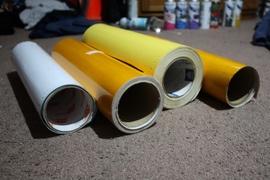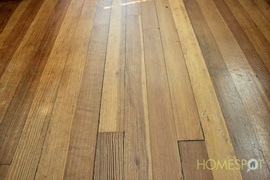How Much Does It Cost to Install Click-Lock Vinyl Flooring?
Click-lock vinyl flooring is one of the easier flooring types to install because it often requires no adhesive. The vinyl hovers above the subfloor’s surface instead of attaching to it, which is known as a floating floor. Two types of vinyl flooring can be found in click-lock styles - luxury vinyl planks (LVP) and luxury vinyl tile (LVT). Floating vinyl floors are durable, long-lasting, and mimic several materials, including wood planks and stone tiles.
The national average cost to install click-lock vinyl flooring is $800 to $2,400, with most people paying around $1,600 to install 200 sq.ft. of 20 mil vinyl click-lock planks with a textured wood grain. This project’s low cost is $600 for 200 sq.ft. of installed 12 mil LVT in a smooth finish. The high cost is $3,200 to install 200 sq.ft. of 40 mil LVP with an exotic wood pattern.
What Is Click-Lock Vinyl Flooring?
Click-lock vinyl 1 flooring is a subtype of luxury vinyl planks and tiles. The material’s edges lock together in a tongue-and-groove application. This means you can install a vinyl floor without adhesives. This makes the installation fast and easy and makes removal faster. Because vinyl tile adhesives grow stronger as they age, glue-down vinyl is very hard to remove. Click-lock vinyl can be pulled up quickly, making repairs and replacements fast and easy.
The material must be installed over a completely flat and smooth substrate. If your floor is not level, you need to use a different material or installation method. Glue-down flooring is appropriate in these instances, including a glue-down vinyl tile or plank.
Click-Lock Vinyl Flooring Cost Calculator
Click-lock vinyl flooring comes in planks and tiles of different thicknesses. Generally, the thicker the material, the more expensive it costs. Very thick planks or tiles can also be more difficult to fit, raising the installation costs. The best-quality material has an inlaid pattern, which is more realistic with a better texture but more expensive than the basic, smooth, printed finishes may be. The following costs are for click-lock vinyl flooring of varying qualities installed in a 200 sq.ft. space.
|
Click-Lock Vinyl Flooring Costs
|
|||
|---|---|---|---|
| Basic | Standard | Best Quality | |
| Click-Lock Vinyl Flooring Cost (Material Only) | $300 - $400 | $500 - $1,200 | $1,400 - $2,000 |
| Click-Lock Vinyl Flooring Installation Cost (Labor Only) | $300 - $400 | $400 - $800 | $800 - $1,200 |
| Total Costs | $600 - $800 | $900 - $2,000 | $2,200 - $3,200 |
| Click-Lock Vinyl Flooring Cost per Sq.Ft. | $3.00 - $4.00 | $4.50 - $10.00 | $11.00 - $16.00 |
Vinyl click-lock flooring has thicknesses categorized by mils, with the standard being around 20 mil. Very thin vinyl may be 12 mil, while very thick vinyl may be 40 mil. Very thin vinyl will often not be very comfortable underfoot and may not last as long. Very thick vinyl can be much more comfortable and springy underfoot and may have limited lifetime warranties from some manufacturers. This can make thicker click-lock vinyl more comfortable and longer-lasting while also being more expensive.
Additional Considerations and Costs
- Underlayment. You should not use underlayment 2 beneath a vinyl click-lock floor, except a vapor barrier in damp areas.
- Radiant heating. You can install radiant floor heating beneath vinyl click-lock flooring. The cost of radiant heating is $10 to $25 a sq.ft.
- Vinyl vapor barrier. When installing click-lock vinyl in a damp area, put down a vapor barrier 3 first. This ensures the moisture does not collect beneath the material.
- Smoother transitions. If you are installing the click-lock vinyl in a room that abuts a room with different flooring, consider installing a threshold or transition strip between them to make the transition smoother. This costs $5 to $30, depending on the material.
- Pets. Vinyl click-lock flooring can be a great material for pets. It tends to be very durable and easy to maintain.
- Sustainability. Some vinyl flooring may contain recycled material, but the material cannot be recycled, meaning this is not considered a sustainable floor.
- Subfloor. Your subfloor 4 must be perfectly smooth and level to install this material. If needed, a new subfloor costs $600 to $2,400.
FAQs
- Do you need an underlay for vinyl click flooring?
No, you should not use underlayment for this material unless it is a vapor barrier in a damp area.
- Is vinyl click-lock flooring waterproof?
Yes, and you can use it in bathrooms, kitchens, basements, and other damp areas without issues.
- Does vinyl click flooring expand?
No, this material is fairly stable and does not expand or contract like wood and laminate flooring.
Remodeling Terms Cheat Sheet
Definitions in laymen's terms, cost considerations, pictures and things you need to know.See full cheat sheet.
 1 Vinyl: A synthetic plastic made from ethylene and chlorine. Vinyl has many applications in the construction industry and it is widely used in sidings, window frames, roofing and gutters, among others
1 Vinyl: A synthetic plastic made from ethylene and chlorine. Vinyl has many applications in the construction industry and it is widely used in sidings, window frames, roofing and gutters, among others
 4 Subfloor: The bottom-most layer of a floor, supported by joists, over which finished flooring material is laid
4 Subfloor: The bottom-most layer of a floor, supported by joists, over which finished flooring material is laid
How much does it cost to install click-lock vinyl flooring in my city?
Cost to install click-lock vinyl flooring varies greatly by region (and even by zip code). To get free estimates from local contractors, please indicate yours.

